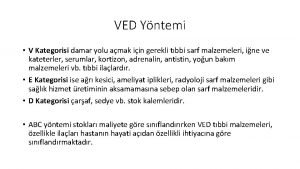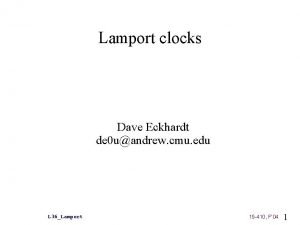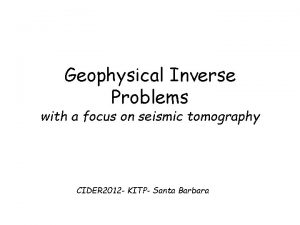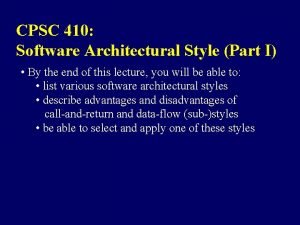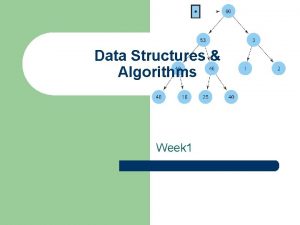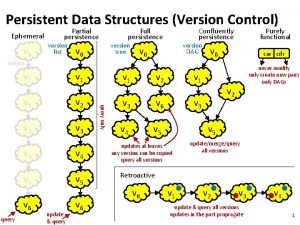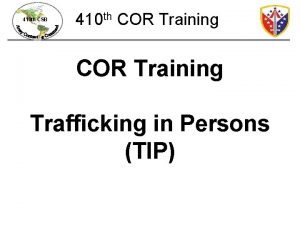Data Structures and Analysis COMP 410 David Stotts








































- Slides: 40

Data Structures and Analysis (COMP 410) David Stotts Computer Science Department UNC Chapel Hill

Tree Data Structures (n-ary tree, binary tree)

On Beyond Lists are linear… each cell has a single “next” “lo” “hi” If we relax this… “ok” allow more than one next we get a TREE “ya”

Tree allows one or more “next” links termed children “lo” “hi” “so” “mi” “ok” “re” “fa” “ya” “ti”

“lo” “ok” “ya” “ti” Tree “hi” “so” “re” “fa” Often draw a tree downwards don’t draw cells Show the “levels” as rows Depth 3 Root “lo” (no in links) “mi” Leaves “ti” “fa” “mi” “so” (no out links)

Tree Terminology �

Tree Terminology �

Recursive Definition “lo” Tree is a root with 0 or more trees under it “hi” “ok” “so” “ya” “ti” “re” “fa” “mi” Tree can be empty too… no nodes at all, no root A special case

“lo” “ok” “ya” “go” The max number of children of a node determines the “arity” of the tree “hi” “re” “fa” “ti” n-ary Tree “zz” “ad” “mi” “k 2” “tu” “so” “no” “ok” “mu” arity 3, a 3 -ary tree

Uses for n-ary Tree � We do need these… like for OS directory structures folders, we have no idea a priori how many sub folders we might have in a folder � Files,

File System Hierarchy

File System Hierarchy

Syntax/Parse Trees

Family Tree



Org Charts

Science Models

Bio Classifications Animalia, Chordata, Mammalia, Carnivora, Canidae, Canis, C. lupus is a path


Traversals Visit all nodes in some order, following edges Come in two flavors: Depth first Basic idea is to travel down paths towards leaves until forced to stop Breadth first Basic idea is to visit all children of a node before going deeper down paths

Depth-First Traversals Visit a node means do something with its data value Pre. Order Visit root, then recursively visit children (L to R) Post. Order Visit children (L to R) and finally visit root In. Order Visit L child, then visit root, then visit R child For n-ary tree, have to decide where in “middle” to put root visit

“lo” “ok” “ya” “re” “fa” “go” “mu” “mi” “zz” “k 2” Pre: lo, ok, ya, re, fa, go, zz, k 2, mi, mu, hi, ad, tu, no, so “hi” “ad” “tu” Post: ya, go, zz, k 2, “so” “no” fa, mi, re, ok, mu, tu, no, ad, so, hi, lo In: ya, ok, go, fa, zz, k 2, re, mi, lo, mu, tu, ad, no, hi, so

Breadth-First Traversal Uses levels to get node order, not tree links Use a Queue data structure Q to keep track a) b) enque root on Q deque a node n from Q and examine it … �“do the work” �enque all children of n into Q c) If empty Q we are done d) !empty Q, then goto setp (b)

“lo” “ok” “ya” “re” “fa” “go” “mu” “mi” “zz” “k 2” Breadth: lo, ok, mu, hi, ya, re, ad, so, fa, mi, tu, no, go, zz, k 2 “hi” “ad” “tu” “so” “no” Use a stack instead of a queue… you get depth-first traversal

Implementing an n-ary Tree Linked cells Tree Cell structure: tree { root: string child 1: tree child 2: tree child 3: tree child 4: tree child 5: tree … } How many children links shall we put in?

Implementing an n-ary Tree Linked cells Tree Cell structure: tree { root: string child 1: tree child 2: tree child 3: tree child 4: tree child 5: tree … } How many children links? • If tree is uniform (all cells have nearly same # children) then this will work ok • If # children varies a lot, then this wastes space • Most cells will have many null pointers (empty subtrees)

Binary Tree case of n-ary tree, has some very important uses � Special � Arity � Call 2, tree with 2 children these left and right children � Implement � We with cell with 2 links (L and R) don’t worry about wasted space

Binary Tree linked structure tree { root: string left: tree right: tree } Compare this to our child/next cell for n-ary tree

Implementing an n-ary Tree let’s reconsider… Linked cells Tree Cell and List cell structure: tree { root: string child: LIST of tree } list { elt: tree next: list } If LIST is null there are no children If not null then order is L to R

Implementing n-ary Tree ( ( “hi” , , null “ok” ) ) ( “fa” , ( “ya” , null ) “mi” ( “ti” , null ) , ) ( “re” , null )

Implementing n-ary Tree “hi” “ok” “ya” “fa” “mi” “ti” “re” arity 3, a 3 -ary tree

Implementing an n-ary Tree Linked cells Every tree cell has a Tree Cell : (root/child/next) • Link to children tree { root: string child: tree nextsib: tree } • Link to next sibling

Implementing n-ary Tree “hi” “ok” “ya” “fa” “mi” “ti” “re” arity 3, a 3 -ary tree

END Beyond this is just templates

ADT: BT of Int Signature � new: Int BT � add. L: BT x Int BT � add. R: BT x Int BT � del. L: BT � del. R: BT � root: BT Int � left: BT � right: BT � get: BT x Int BT � isin: BT x Int Boolean (searching) � size: BT Nat (natural number) � empty: BT Boolean

Behavior for LIST ops: new, add, rem, get, find, size, empty � Axioms LHS � rem( new(), i ) = ? rem( ins(L, e, k), i ) = ? get( new(), i ) = ? get( ins(L, e, k), i ) = ? find( new(), e ) = ? find( ins(L, e, i), f ) = ? size( new() ) = ? size( ins(L, e, i) ) = ? empty( new() ) = ? empty( ins(L, e, i) ) = ?

Behavior for LIST 1. 3 size( new() ) = size( ins(L, e, i) ) = empty( new() ) = empty( ins(L, e, i) ) = get( new(), i ) = get( ins(L, e, k), i ) = 0 size(L) + 1 true false err if ( i=k ) then e else get( L, i )

LIST Implementation linked structure head 31 17 8 1 ins( 27, 2 ) 31 8 17 head 27 1

Tree Implementation � Linked: Time complexity of operations ◦ ins. Cell ◦ del. Cell O(1) ◦ ◦ ◦ O(n) content O(1) O(n), O(1) O(n) + O(1) get find empty size ins(e, i) get ◦ rem(i) move 2 link pointers + searching is O(n) ins. Cell O(n) + O(1) is O(n)
 Comp 410
Comp 410 Homologous structures examples
Homologous structures examples Inverted indexing
Inverted indexing Ved yöntemi
Ved yöntemi Kov-21 skl
Kov-21 skl 15-410 cmu
15-410 cmu Iat 410
Iat 410 Si-410
Si-410 Si-410
Si-410 6-12/410
6-12/410 Pengertian pangkat akar dan logaritma
Pengertian pangkat akar dan logaritma The bradley family owns 410 acres
The bradley family owns 410 acres What is cross projection sketch
What is cross projection sketch Section 16–3 the process of speciation (pages 404–410)
Section 16–3 the process of speciation (pages 404–410) Ipm 410-3 (shikha) price
Ipm 410-3 (shikha) price Svsd 410
Svsd 410 Si 410
Si 410 Buss 410
Buss 410 Alunda innebandy
Alunda innebandy Cse 410
Cse 410 Cpsc 410
Cpsc 410 Barracuda web filter 410
Barracuda web filter 410 Comp set data
Comp set data Professor ajit diwan
Professor ajit diwan Kevin wayne princeton
Kevin wayne princeton Data structures and algorithms tutorial
Data structures and algorithms tutorial Conditional macro expansion in system software
Conditional macro expansion in system software Assembler algorithm and data structures
Assembler algorithm and data structures Information retrieval data structures and algorithms
Information retrieval data structures and algorithms Data structures and abstractions with java
Data structures and abstractions with java Data structures and algorithms bits pilani
Data structures and algorithms bits pilani Adts, data structures, and problem solving with c++
Adts, data structures, and problem solving with c++ Ajit diwan iit bombay
Ajit diwan iit bombay Data structures and algorithm
Data structures and algorithm Data structures and algorithms
Data structures and algorithms Data structures and algorithms
Data structures and algorithms Waterloo data structures and algorithms
Waterloo data structures and algorithms Information retrieval data structures and algorithms
Information retrieval data structures and algorithms Ephemeral data structure
Ephemeral data structure Data structures and algorithms
Data structures and algorithms Procedures of data collection
Procedures of data collection



